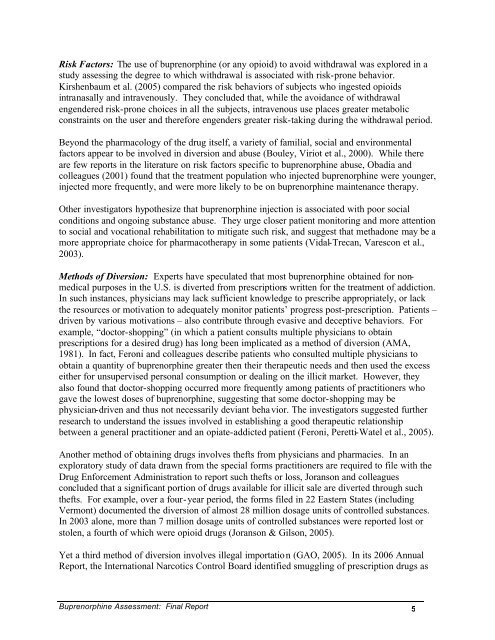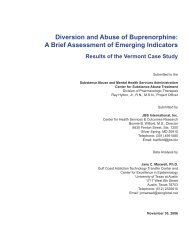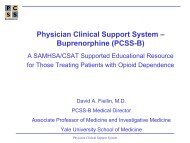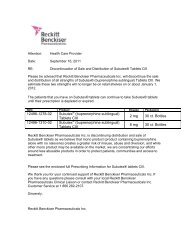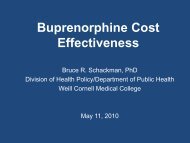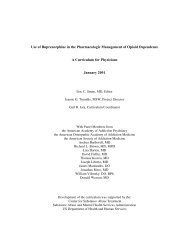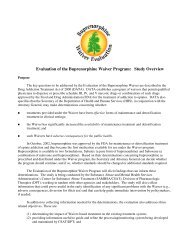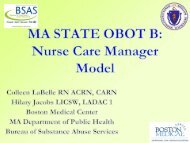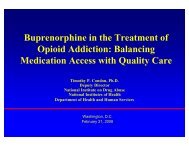Diversion and Abuse of Buprenorphine
Diversion and Abuse of Buprenorphine
Diversion and Abuse of Buprenorphine
Create successful ePaper yourself
Turn your PDF publications into a flip-book with our unique Google optimized e-Paper software.
Risk Factors: The use <strong>of</strong> buprenorphine (or any opioid) to avoid withdrawal was explored in a<br />
study assessing the degree to which withdrawal is associated with risk-prone behavior.<br />
Kirshenbaum et al. (2005) compared the risk behaviors <strong>of</strong> subjects who ingested opioids<br />
intranasally <strong>and</strong> intravenously. They concluded that, while the avoidance <strong>of</strong> withdrawal<br />
engendered risk-prone choices in all the subjects, intravenous use places greater metabolic<br />
constraints on the user <strong>and</strong> therefore engenders greater risk-taking during the withdrawal period.<br />
Beyond the pharmacology <strong>of</strong> the drug itself, a variety <strong>of</strong> familial, social <strong>and</strong> environmental<br />
factors appear to be involved in diversion <strong>and</strong> abuse (Bouley, Viriot et al., 2000). While there<br />
are few reports in the literature on risk factors specific to buprenorphine abuse, Obadia <strong>and</strong><br />
colleagues (2001) found that the treatment population who injected buprenorphine were younger,<br />
injected more frequently, <strong>and</strong> were more likely to be on buprenorphine maintenance therapy.<br />
Other investigators hypothesize that buprenorphine injection is associated with poor social<br />
conditions <strong>and</strong> ongoing substance abuse. They urge closer patient monitoring <strong>and</strong> more attention<br />
to social <strong>and</strong> vocational rehabilitation to mitigate such risk, <strong>and</strong> suggest that methadone may be a<br />
more appropriate choice for pharmacotherapy in some patients (Vidal-Trecan, Varescon et al.,<br />
2003).<br />
Methods <strong>of</strong> <strong>Diversion</strong>: Experts have speculated that most buprenorphine obtained for nonmedical<br />
purposes in the U.S. is diverted from prescriptions written for the treatment <strong>of</strong> addiction.<br />
In such instances, physicians may lack sufficient knowledge to prescribe appropriately, or lack<br />
the resources or motivation to adequately monitor patients’ progress post-prescription. Patients –<br />
driven by various motivations – also contribute through evasive <strong>and</strong> deceptive behaviors. For<br />
example, “doctor-shopping” (in which a patient consults multiple physicians to obtain<br />
prescriptions for a desired drug) has long been implicated as a method <strong>of</strong> diversion (AMA,<br />
1981). In fact, Feroni <strong>and</strong> colleagues describe patients who consulted multiple physicians to<br />
obtain a quantity <strong>of</strong> buprenorphine greater then their therapeutic needs <strong>and</strong> then used the excess<br />
either for unsupervised personal consumption or dealing on the illicit market. However, they<br />
also found that doctor-shopping occurred more frequently among patients <strong>of</strong> practitioners who<br />
gave the lowest doses <strong>of</strong> buprenorphine, suggesting that some doctor-shopping may be<br />
physician-driven <strong>and</strong> thus not necessarily deviant behavior. The investigators suggested further<br />
research to underst<strong>and</strong> the issues involved in establishing a good therapeutic relationship<br />
between a general practitioner <strong>and</strong> an opiate-addicted patient (Feroni, Peretti-Watel et al., 2005).<br />
Another method <strong>of</strong> obtaining drugs involves thefts from physicians <strong>and</strong> pharmacies. In an<br />
exploratory study <strong>of</strong> data drawn from the special forms practitioners are required to file with the<br />
Drug Enforcement Administration to report such thefts or loss, Joranson <strong>and</strong> colleagues<br />
concluded that a significant portion <strong>of</strong> drugs available for illicit sale are diverted through such<br />
thefts. For example, over a four-year period, the forms filed in 22 Eastern States (including<br />
Vermont) documented the diversion <strong>of</strong> almost 28 million dosage units <strong>of</strong> controlled substances.<br />
In 2003 alone, more than 7 million dosage units <strong>of</strong> controlled substances were reported lost or<br />
stolen, a fourth <strong>of</strong> which were opioid drugs (Joranson & Gilson, 2005).<br />
Yet a third method <strong>of</strong> diversion involves illegal importation (GAO, 2005). In its 2006 Annual<br />
Report, the International Narcotics Control Board identified smuggling <strong>of</strong> prescription drugs as<br />
<strong>Buprenorphine</strong> Assessment: Final Report 5


